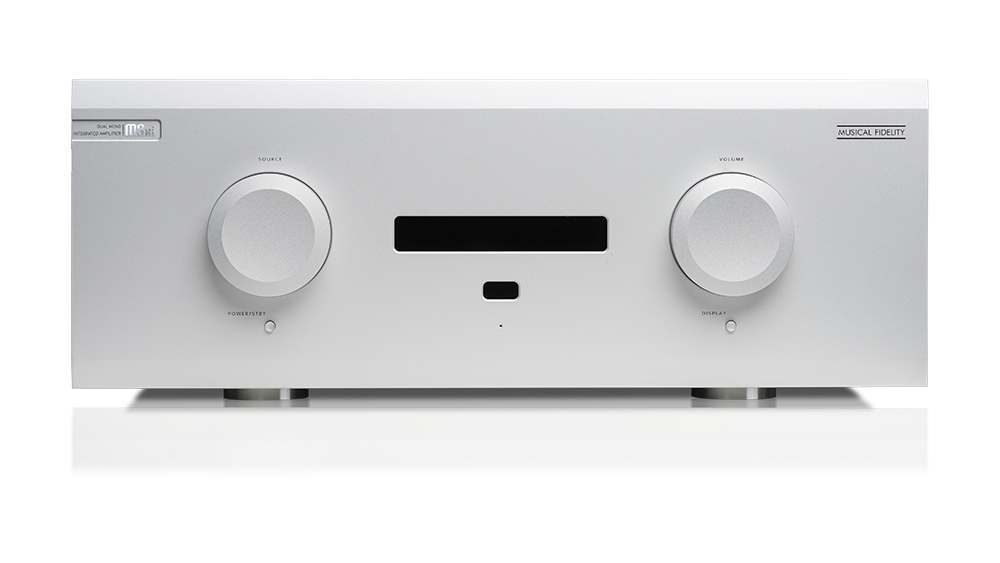What Hi-Fi? Verdict
More power than you’ll ever need, super-low distortion, inaudibly low circuit noise, a great digital front-end and an even-better analogue one.
Pros
- +
Power, power power!
- +
Lovely sound
- +
On-board USB DAC
Cons
- -
Phono input
- -
Headphone output
Why you can trust What Hi-Fi?
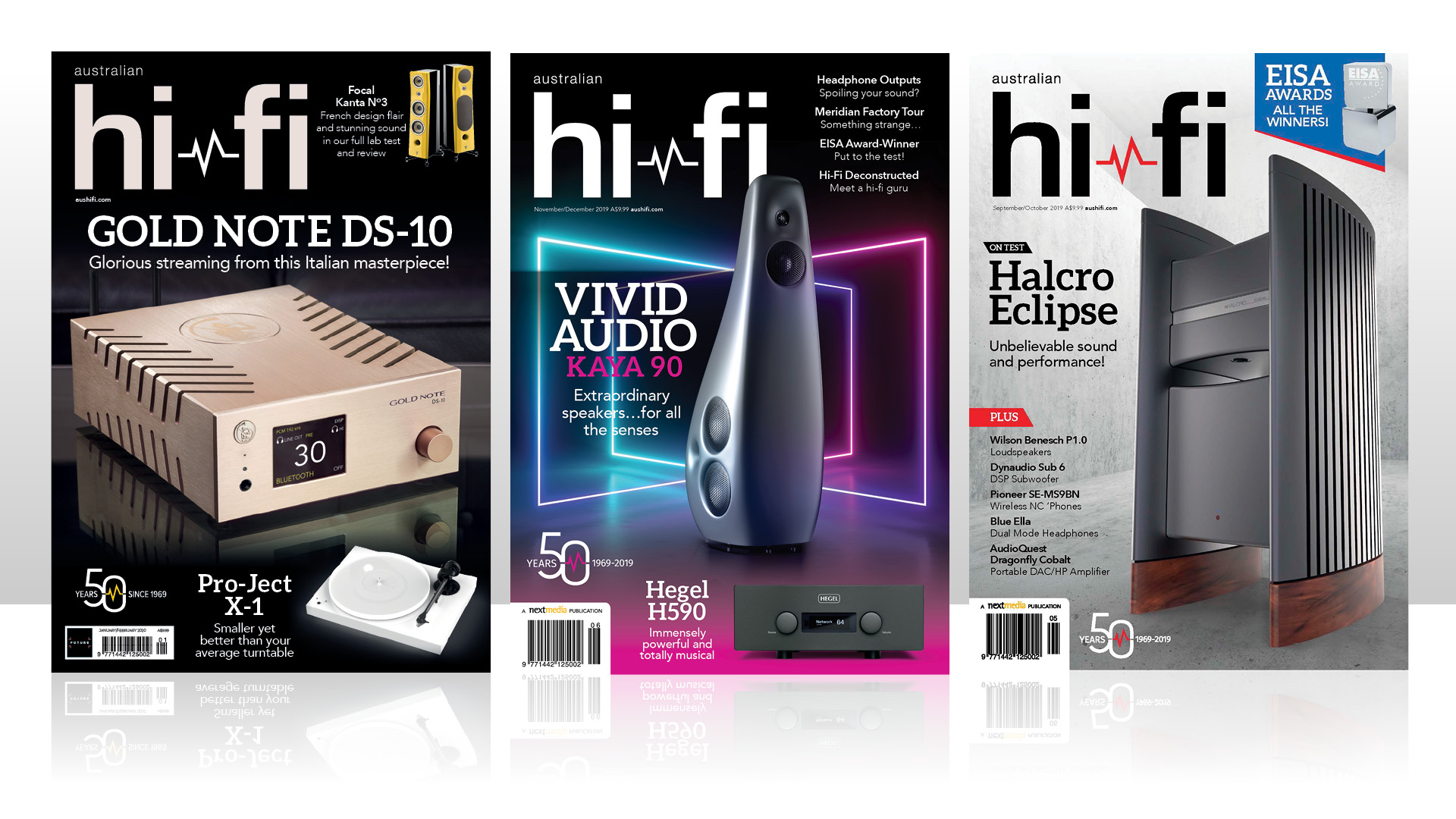
This review and test originally appeared in Australian Hi-Fi magazine, one of What Hi-Fi?’s sister titles from Down Under. Click here for more information about Australian Hi-Fi, including links to buy individual digital editions and details on how to subscribe. Read What Hi-Fi?'s global, star-rated Musical Fidelity M8xi review.
STOP PRESS: In Australia, the price of the M8xi has been reduced from A$12,000 to A$9,450, as of July 2021. This is not because of a beneficial change in exchange rates, but to combat grey imports, with the Australian distributor Audio Marketing noting:
"Most brands will suffer at the hands of grey importers at some stage, but the importers of Musical Fidelity have decided to meet fire with fire, and have drastically reduced prices to combat the threat. While Audio Marketing openly acknowledges that their newly announced pricing is unsustainable in the long run they believe that it is important that their existing dealer network reaps the benefit of their investment, demonstrations and brand commitment, rather than see their work picked off by a faceless third party based on price alone."
By pricing Musical Fidelity products at or close to the prices offered by grey importers, while still offering full brand support, Audio Marketing may indeed be delivering the lowest Musical Fidelity prices in the world, aiming to give potential purchasers a clear, legitimate and risk-free path to purchase.
With that happy announcement concluded, let's continue with our full review...
--------------
Do you know what would improve Musical Fidelity’s new M8xi integrated amplifier immediately? Feet. Four of them. Four big large feet. Oh, and handles. Four of them too. But I’ll get to grips with those issues a bit later in this review.
Probably the important thing I can say about this new M8xi is that unlike many famous companies that have been sold whose new owners have subsequently, let us say, “dropped the ball”, Musical Fidelity’s new owner, Heinz Lichtenegger, has instead moved the company to the top of the hi-fi league table.
Not only has Lichtenegger retained the services of long-time Musical Fidelity designer Simon Quarry, he has also decided that rather than shifting the production of Musical Fidelity’s components to one of his own factories in the Czech Republic or Slovakia, where he builds his Pro-Ject turntables and electronics, he’ll instead keep building Musical Fidelity components in the same high-tech factory that’s been building them for the past 30 years or so.
The latest hi-fi, home cinema and tech news, reviews, buying advice and deals, direct to your inbox.
Lichtenegger and Quarry have obviously also decided to put power output front and centre again at Musical Fidelity, because the M8xi’s output power, at 550-watts per channel into 8Ω, makes it not only the most powerful integrated amplifier in Musical Fidelity’s current extensive line-up, but also the most powerful integrated amplifier Musical Fidelity has ever built, being just that bit more powerful than the KW500, which was rated at 510-watts per channel.
Equipment
There’s very little on the front panel of the M8xi to suggest that it’s a very full-featured integrated amplifier, with multiple analogue and digital inputs. Indeed there’s very little on the front panel at all, as you can plainly see for yourself!
The front panel’s control and display layout would would certainly have found favour with famous English poet William Blake because, like his poem ‘The Tyger’, it’s wonderfully symmetrical, indeed almost perfectly so.
The perfectionist in me says that had I been responsible for the design, I’d most certainly have shifted the word ‘Display’ to the right of the button below the volume control, and made the ‘Musical Fidelity’ logo at the top right of the front panel more visually resemble the model name at the top left. But that’s just me.
As for the operation of this control, pushing it repeatedly will cycle the brightness of the front panel’s display through its three available levels, and along the way give you the option of switching the display off entirely.
If you choose to have the display off, you’ll find that if you adjust either the volume control above it, or the input source selector at left, the display will switch on briefly so you can see what’s going on – though it does this so briefly (only for around 2.5 seconds) that you’ll have to be careful not to blink. I personally would have appreciated the display being active for just a few seconds longer!
The source selector toggles through the available sources – Bal 1, Bal 2, CD, Tuner, Aux 1, Aux 2, Coax 1, Coax 2, Opt 1, Opt 1 and USB – as you rotate it clockwise. And because it’s an encoder rather than a switch, if you go clockwise from USB, you’ll find you’re back at Bal 1. This means that if you choose your rotational direction wisely, you can speed up input source selection quite appreciably.
The volume control is also a rotary encoder, by the way, not an ordinary potentiometer, but unlike many encoders, it has a linear action on volume adjustment, so moving it quickly does not affect the speed of the volume change, which occurs in exact 0.5dB steps across the entire gain range.
As for that button underneath the source selector, it’s the smallest power/standby switch I think I’ve ever seen… but of course it had to be in order for the front panel to be symmetrical!
It would appear to me that this seemingly insistent search for symmetry has resulted in one casualty, because putting a headphone socket on the front panel would indeed have destroyed the symmetry. If this was, in fact, the reason for its omission, I would have suggested putting two of them on the front panel.
Yes, you could always add a standalone external headphone amplifier (there are multiple outputs on the rear panel that can be used for this purpose), but I really would have preferred it if Musical Fidelity had fitted a standard 6.35mm headphone output socket… even if it had to be on the rear panel, rather than on the front.
Internal circuitry
As you’ve likely guessed from the size and weight of the M8xi and the extensive heat-sinking down either side, it’s a linear Class-A/B amplifier with a linear power supply… two linear power supplies, actually, because the M8xi is essentially a pre-amplifier (with a digital input section) followed by dual mono power amplifiers.
The left and right channels are completely separate, to the point of each having its own toroidal power transformer to step down the 240V mains power. Says Quarry: “The M8xi is a separate pre-amp with two monobloc power amps sharing a common chassis. Each has its own heat sink and separate transformer. Genuinely dual mono. The pre-amp has its own separate power supply and is mounted close to the input sockets.”
The power supply to the output stage is quite unusual, because each of the twelve Sanken bipolar output devices has its own dedicated 4700µF/80V capacitor, rather than all the transistors being fed from a common capacitor bank, which is apparently a design trick trickled down from Musical Fidelity’s massive Titan amplifier.
The M8xi also uses an output stage topology that’s been a feature of many previous of Musical Fidelity’s high-power amplifiers, which is that the very high output power is achieved by bridging two amplifiers, so there are actually four mono amplifiers inside the M8xi, with their outputs linked together.
This means that both the positive and the negative speaker output terminals supply voltage, which in turn means that the negative terminal should never be grounded.
The practical effect of this is that it means that you should only ever connect ordinary passive loudspeakers to the M8xi’s output terminals since if you connect an active device, such as a powered subwoofer or a pair of electrostatic loudspeakers, you cannot be certain that their negative terminals are not connected to earth.
The M8xi’s digital inputs end up at a Texas Instruments PCM5242 DAC, which means that although it will handle PCM up to 24/192kHz via its coaxial inputs (and up to 24/96 via optical), its USB input is limited to 24/192kHz PCM, so no DXD or DSD. If, like me, you’re one of those audiophiles who doesn’t own much music in a higher-resolution format than 24/196, this isn’t really going to matter to you.
Whilst I do own music in all the high-res formats, I do so only so I can test format compatibility when reviewing, because I think long word-lengths and high bit-rates are total overkill for music files. Personally, I am perfectly happy listening to 24/96 files or even bog-standard 16-bit/44.1kHz files.
It’s particularly good that I am happy listening to 16-bit/44.1kHz files, because at least 98 per cent of my digital music library (as distinct from my analog music library!) is comprised of files in the Red Book format.
You also have to take into account the undeniable fact that almost all recorded music is only 16-bit/44.1kHz quality – most so-called ‘high-res’ files contain only 16-bit/44.1kHz digital information that has been ‘repackaged’ into a higher-res format in order that unwitting consumers can be flogged yet another version of music they already own... and yes, Amazon Music, I’m looking at you (but there are plenty of others).
It’s also an uncomfortable truth that most people cannot tell the difference between music recorded and played back using 16-bit/44.1kHz coding and the same music recorded and played back at higher resolution. This fact was recently documented in an Audio Engineering Society Convention Paper presented by Mark Waldrep, titled “Native High-Resolution versus Red Book Standard Audio: A Perceptual Discrimination Survey.”
Rear panel and more
It’s always good to mention the elephant in the room before anyone notices, but in this case, it’s more of a pygmy elephant than a full-sized pachyderm. I refer, of course, to the absence of a phono input on the M8xi.
Not only is there no moving-coil input, there’s not even a moving-magnet input, so you can’t plug your turntable directly into the M8xi… at least you can’t unless it’s one of the increasing number of turntables that has a line-level output, in which case you could use Aux 1 or Aux 2.
Again, this doesn’t worry me at all, because I’d never use a built-in phono stage… give me a stand-alone phono stage any time and, preferably, a passive device, such as my trusty Grace GS-10 (an oldie but a goodie!).
Of course you might want to use an active stage so you can use multiple cartridges, or because you want to provide perfect impedance-matching (particularly important with moving-coil devices), but no matter whether you use a passive or an active phono pre-amplifier, it’s going to beat the hell out of any phono stage any manufacturer builds in.
The M8xi not having a phono stage also means you can choose how much money you want to invest in your hi-fi system. If you don’t play LPs at all, it’s zero, zip… nada. If you want to play only the odd LP, you can pick up a pretty decent outboard phono stage (such as a Pro-Ject Phono Box or an NAD PP 2e) for only a few hundred bucks.
And if you’re a true vinylista, you’ll either already have your own phono stage, or you’ll want to invest in one whose performance is commensurate with the quality of your turntable and phono cartridge.
Anyway, now that I’ve put the elephant back in the cupboard, what’s left to talk about on the rear panel? Quite a lot, as you can see from the photograph of it.
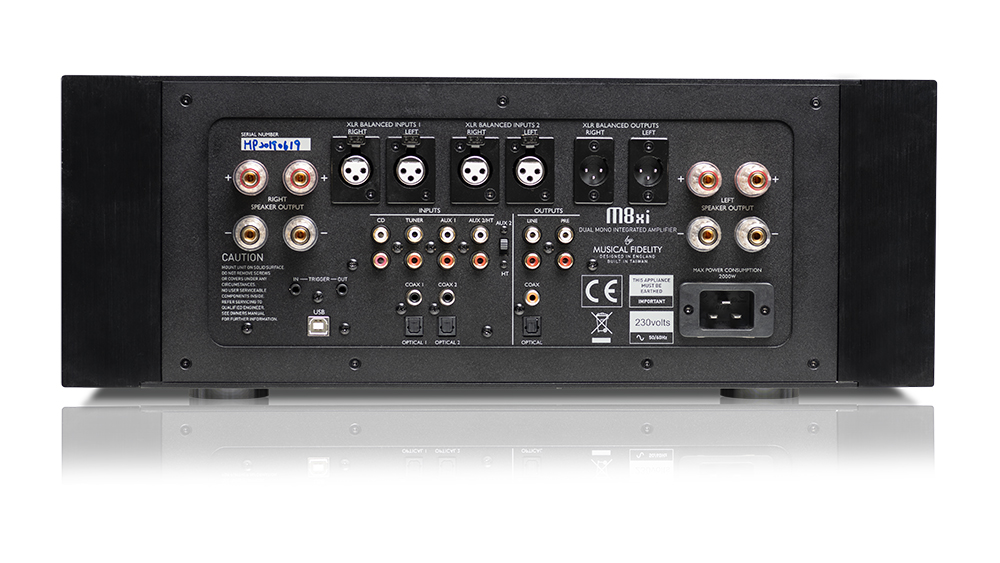
The speaker output terminals are very large, heavy-duty multi-way types and there are two pairs per channel, so you can run separate speaker cables to high-pass and low-pass sections of your loudspeakers. I would have preferred the negative terminals to be coloured blue or white (instead of black) to suggest they’re not referenced to ground, but Musical Fidelity does give plenty of warnings about this in its excellent Owners’ Manual.
I admit that since I had, for once, actually read the advertising material before the review amp was delivered and noticed there was supposed to be a Home Theatre throughput, I had wondered why I couldn’t find it whilst checking out the source selector.
As it happens, it was only when I got around to looking at the rear panel that I found that the Aux 2 input has an associated switch that converts it to a home theatre throughput, in which configuration the M8xi’s volume control is bypassed. That said, it is better that this switch is on the rear panel, rather than on the front (as it often is!) because this location virtually eliminates the possibility of any expensive mistakes being made.
The rear panel also has both line outputs and pre-outputs, one of which gives a fixed voltage signal and the other a volume-controlled one, so if you did want to connect a powered subwoofer, this would be the place to do it.
One oddity on the rear panel is the provision of an IEC C19-type 240V mains power socket, which has a different earth/neutral/active pin layout to a standard 240V socket. So make sure you don’t lose the 15-amp power cord supplied by Musical Fidelity, because the 10-amp versions won’t be thick enough for an amplifier as powerful as the M8xi, the earth pin on the plug of the 16-amp versions will be too large to fit into standard Australian 240V mains power sockets and the 15-amp cables are as rare as hen’s teeth.
Unless you’re an Olympic weightlifter, I do not recommend you try to pick up an M8xi by yourself, not least because it’s nearly half a metre deep, so there’s no way you could snatch and grab it. But even with two people sharing its 46kg dead weight it’s not an easy lift because the four feet that Musical Fidelity has fitted (remember my mention about them in the introduction?) elevate the amp only 9mm above whatever surface it’s resting on, which makes it pretty well impossible to get your fingers underneath it to make the lift in the first place.
The only saving grace when you are lifting the amplifier is that, thanks to the use of two power transformers, the weight is fairly evenly balanced, so once you have squeezed the tips of your fingers underneath (yes, it can be done… just), moving it becomes a bit… but only a bit… easier.
My take on this small design quirk is that Musical Fidelity should either do the easiest thing, which is replace the existing feet with ones that lift the chassis at least 15mm higher than whatever it’s sitting on and/or add handles to the front and/or back to facilitate transportation.
As for the M8xi being half a metre deep, it’s also only 15mm shy of being half a metre wide as well, so it won’t really matter how the two of you position yourselves when lifting it. The height? Glad you asked. It’s 180mm, which is just shy of the width of the magazine you’re reading now.
There is one bit of good news involving moving the M8xi around, which is that all that extensive heat-sinking down either side not only looks good, but Musical Fidelity has rounded off all the edges of the heatsink fins so you can’t accidentally cut yourself on them or rip your clothing.
Oh, and one more thing, just in case I may have given you the wrong impression in my introduction, the Musical Fidelity M8xi may have been commissioned in Austria (headquarters of Audio Tuning Vertriebs GmbH, owned by Heinz Lichtenegger) and designed in Great Britain, by Simon Quarry, but it is manufactured in Taiwan in the same factory in which Musical Fidelity’s equipment has been made for a very long time.
Auditioning
On switch-on, the Musical Fidelity shows its model number in the display (though with the ‘xi’ shown in capitals, rather than in lower case) after which it takes 15-seconds to initialise, after which it then automatically selects whatever input you last used and whatever volume level you were last playing at.
Because this is all done electronically, I was expecting that I might be able to control turn-on level, or maximum level, or level-trim the inputs, but this functionality is not provided. The remote control adds additional functionality though, because in addition to being able to control volume, switch inputs and so on, it adds a ‘Mute’ function so you can instantly mute (and un-mute) the audio signal.
The display shows active input at its left end and the volume level (in 0.5dB increments) in use at its right end, both in a champagne-blue-on-black read-out that I initially thought was a little blurry but didn’t worry about because I didn’t have my glasses on. However, after I’d put on my glasses, the display still seemed just very slightly blurry.
This may have indeed been my eyes, or it may have been my review unit (which was an early production sample), but it’s of no real import either way, since the display itself is entirely legible, even from a quite a ‘way off, even if it’s not quite ‘sharp’.
One thing I really, really, liked about the display is that when you’re switching it on or off, the print on it is ‘wiped’ out as if a curtain is being drawn across it, rather than just being extinguished. It’s a small and seemingly inconsequential thing, but it really imbued the amplifier with a touch of class. It made me feel good about it.
Most amplifier designs involve some kind of compromise, so that if the designer wants to deliver tremendous dynamics, high power output is required. However high-power output devices almost always compromise low-level detailing. If, on the other other hand, the designer optimises the amplifier by using lower-powered output devices to deliver the ultimate in low-level detailing, dynamism is inevitably restricted.
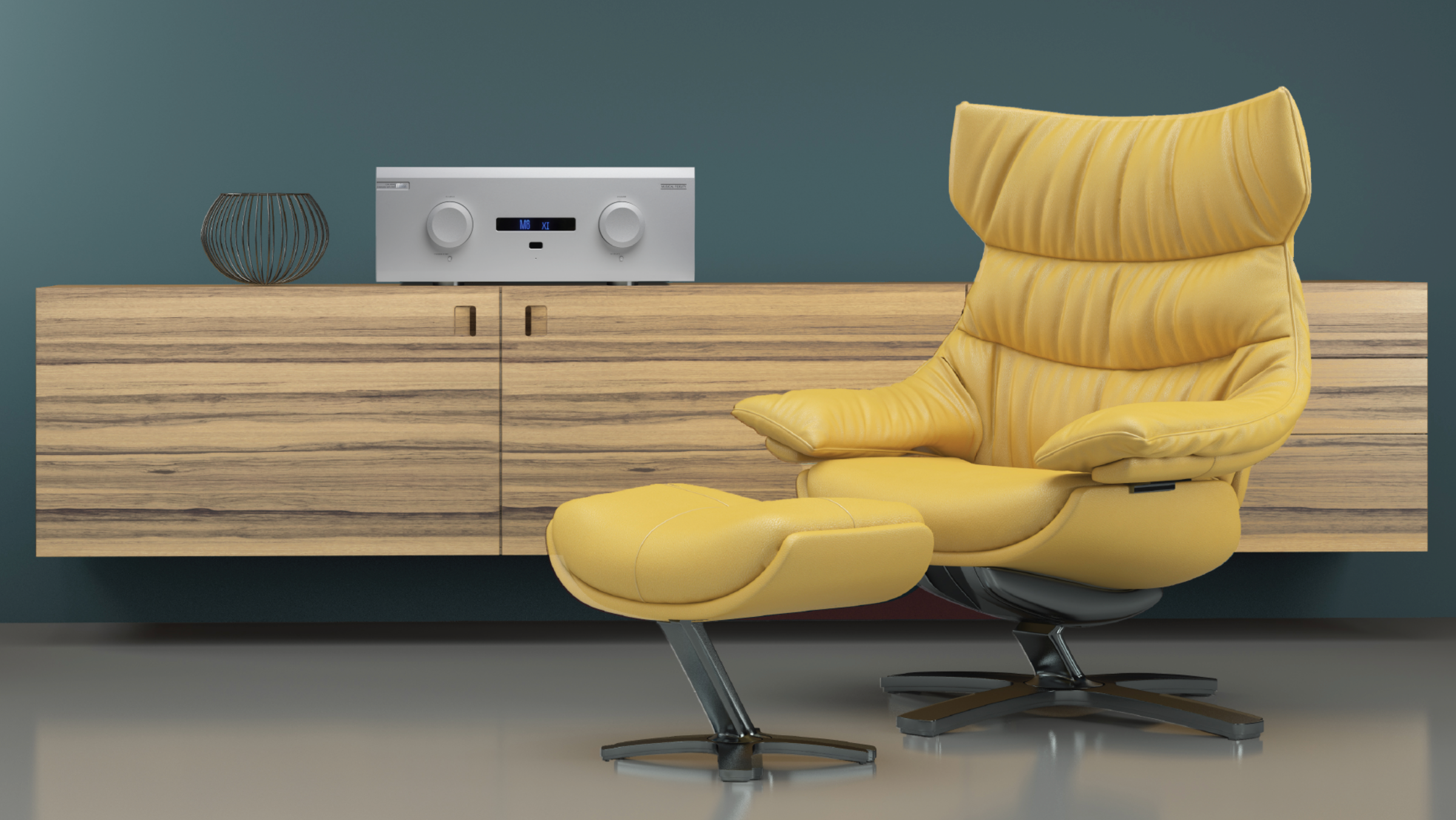
Even the briefest listen to a Musical Fidelity M8xi will reveal that with his bridged output stage design, Simon Quarry has delivered the best of both worlds – an amplifier with essentially unbeatable real-world dynamics that can nonetheless reveal the tiniest of musical minutiae.
I should note for the record that Quarry has put on record that the design of the M8xi was not all of his own doing. He credits not only Heinz Lichtenegger but also “key staff at Audio Tuning’s manufacturing partners, Canor Spol sro and HiPro.”
Not that I had a “brief listen.” In proof positive that it’s an ill wind that blows no good, the Covid-19 pandemic meant that I was able to listen to the Musical Fidelity M8xi for far longer than I am usually able and I would like to make it perfectly clear right at the outset that the more I listened, the more I liked it.
Again, thanks to Covid-19 I had more speakers on hand than usual and the M8xi drove all of them perfectly to the maximum volume levels of which they were capable.
Even when those speakers were delivering signs of being overdriven (which in two cases meant that the music was very, very loud indeed, because these two models could handle scads of power!), the M8xi was simply purring along, not even raising a sweat… and I kind of mean that literally, as well as figuratively, because even after playing the amplifier long and hard, its heatsinks remained relatively cool to the touch.
And, whereas when some amplifiers are playing ‘loud’ their sound becomes a tad congested, the sound of the Musical Fidelity M8xi was as pure and diaphanous at high volume levels as it was down at “is there any music playing?” levels.
Listen to Madonna’s Vogue at high volume and even though you’ve probably heard it a thousand times you will hear quite a few things you have never heard before, such as the precise pitch of every single one of the notes of that super-deep iconic house bass line. You’ll not only hear the clearly delineated pitch of the notes, but also the ‘bounce’ of the notes as well. Then later on, in the spoken list of dancers and actors, you’ll find you can not only count the echoes but also feel the fades. This is musical detailing at its best.
You can also hear the M8xi’s control of bass, pace and timing listening to The Beautiful People from Marilyn Manson’s Lest We Forget: The Best Of Marilyn Manson (though originally released on Antichrist Superstar.) Because it’s Manson, you must listen with the volume cranked to 11, and when you do, the sonic attack of the drums is truly visceral, but it at least prepares your ears for the power guitar chords that follow.
This is a great album by the way. If you haven’t heard it you’ll particularly love their version of the Eurythmics’ Sweet Dreams (Are Made Of This). And if you’re listening with the M8xi and a pair of speakers with great tweeters, you should particularly admire the sweetness of the tinkling synth at around 3:15 in.
You’ll be able to fully appreciate the midrange delivery of the M8xi by listening to Radiohead’s masterful A Moon Shaped Pool. The way Yorke’s voice is always front, centre and ethereally at arm’s length from the supporting instrumentation and effects is quite magical. There are so many disparate music lines in almost all the tracks on this album that most amplifiers just give up and sound grungy, but the Musical Fidelity M8xi revels in delivering the complete soundscape with unerring accuracy.
Listen, for example, to the tonal change in the heart-beat opening to Desert Island Disk, then admire how well the M8xi delivers the contrasts between the acoustic and electric guitars and the synthesised sounds. And through it all Yorke’s voice is as mournful as it’s ever been. But perhaps not quite so mournful as it is on the version of True Love Waits that’s delivered here, with only piano(s) as accompaniment. The manipulated piano sounds build to become all-encompassing before a beautiful fade.
To admire the incredible dynamism of which the Musical Fidelity M8xi is capable, you just have to listen to the way it handles The Cat Empire’s So Many Nights. I was fairly late to the Cat Empire party, but was a fan in time to hear their incredible concerts at the Metro back in 2007. Concerts plural because I was lucky enough to go twice.
There are few albums where you can hear a band is having fun making the album, and this is one of them. The fun is infectious too. By the time you get to Fishies, you’ll be up singing “welcome fishies to my hook” along with Felix Riebl and shaking imaginary marimbas.
You will have to put up with them letting Angus have his fun by singing on three tracks, but just when you were thinking The Darkness was running too long, along comes Riebl’s delicious vocal on i. (Actually, Angus sounds pretty good on Lonely Moon, though every time I hear it I can’t get over the feeling that they should have been paying Van Morrison royalties.)
And listen to the way the M8xi delivers the cymbal sound against the Hammond and the piano and drums. Amazing!
As for concert sound, you can hear how realistically the M8xi delivers it by listening to Bad Company’s Feel Like Making Love from their Wembley concert in 2010. There’s that lovely intro on acoustic guitars, accompanied by claps and cheers from the crowd, then, when the entire band chimes in, the richness of the bass sound is incredible, plus the sound of Rodgers’s voice is even more incredible. Later on, the harmonica is great as well.
And if listening to this makes you go back and hear his voice sounding even better on 1975’s Straight Shooter, well so much the better! Rodgers had arguably the greatest male voice in rock n’ roll back in the 70s and when you hear the Wembley concert, you won’t believe you’re listening to a sexagenarian (he was born 1949). Rolling Stone did rank him at No 55 on its ‘100 Greatest Singers of All Time’ list, but I think he deserved to be ranked much higher.
Throughout my listening sessions I took the opportunity whenever I had identical material in three different formats to compare the analogue (XLR) inputs against the digital input and the USB input and every time I did I had to raise my eyebrows, because the MX8i delivered sound across the three inputs that was virtually indistinguishable.
If you choose really demanding material, listen very, very hard and take copious notes while you’re listening, you’d probably end up ranking them in the order you’d expect (XLR first, with S/PDIF and USB tied for second) but in any real-world listening situation, all three would be standing on the highest tier of the podium.
With regard to the quality of the on-board DAC my advice would be that unless you already own a high-quality DAC, you’ll be more than happy with the one inside the Musical Fidelity M8xi. And if you don’t already own one, you’re going to have to search very hard – and hand over lots of cash – to find one that sounds better than the one that’s inside the M8xi.
Conclusion
If you’re reading this review with the intention of buying a Musical Fidelity M8xi, you probably won’t need me to tell you that it has already won the prestigious EISA 2020–2021 award for “Best High-End Integrated Amplifier” and here in Australia it has also picked up a gong from Sound+Image Magazine for being “Best Amplifier of Year 2020–2021” in the AU$10,000 to AU$20,000 category.
I can certainly see why the many different judges bestowed these awards. The Musical Fidelity M8xi has more power than you’ll ever need, super-low distortion, inaudibly low circuit noise, a great digital front-end and an even-better analogue one, plus it sounds superb.
Lab test results
Newport Test Labs measured the power output of the Musical Fidelity M8xi integrated amplifier as being 557-watts per channel (27.4dBW) into 8Ω, both channels driven at all three frequencies tested: 20Hz, 1kHz and 20kHz, so it’s safe to say the amplifier will deliver this output at any audio frequency.
When just a single channel was driven, output power increased slightly (by 0.3dB) to 595-watts per channel. Since Musical Fidelity rates power output into 8Ω as 500-watts per channel, it comes in as ‘better than specification’ on this test.
When the Musical Fidelity M8xi was driving a single channel into 4Ω loads, the amplifier delivered 806-watts per channel (29.0dBw) at 1kHz and 20kHz, but this output reduced by 0.3dB to 754-watts per channel (28.7dBw) when both channels were driven and was somewhat lower when measured using a 20Hz test signal. The reason for the discrepancy between the measured results and the specification is explained in the following paragraph, but the differences are mostly less than 1dB and so are of no consequence.
The reason for the slightly reduced output was due to the M8xi’s internal protection circuitry triggering at these power levels, so I can only presume that the specifications were derived using an amplifier which had had its protection circuit temporarily disabled. As it is, the difference between even the lowest power output measured by Newport Test Labs and Musical Fidelity’s specification is only 0.7dB, as noted in the previous paragraph, and this difference is too small to be significant, much less audible.
You should also note that the protection only triggered because the lab uses continuous sine waves for testing: The output protection would not be triggered by music signals, so the M8xi would produce more than its rated output when reproducing music. The protection also triggered only with 4Ω loads, and not at all when the amplifier was connected to 8Ω loads.
You can see the black trace is the smoother of the two and shows a response of 20Hz to 40kHz ±0.25dB. And although the response into the simulated speaker load is a little less linear, the overall response is almost identical at 20Hz to 40kHz ±0.3dB.
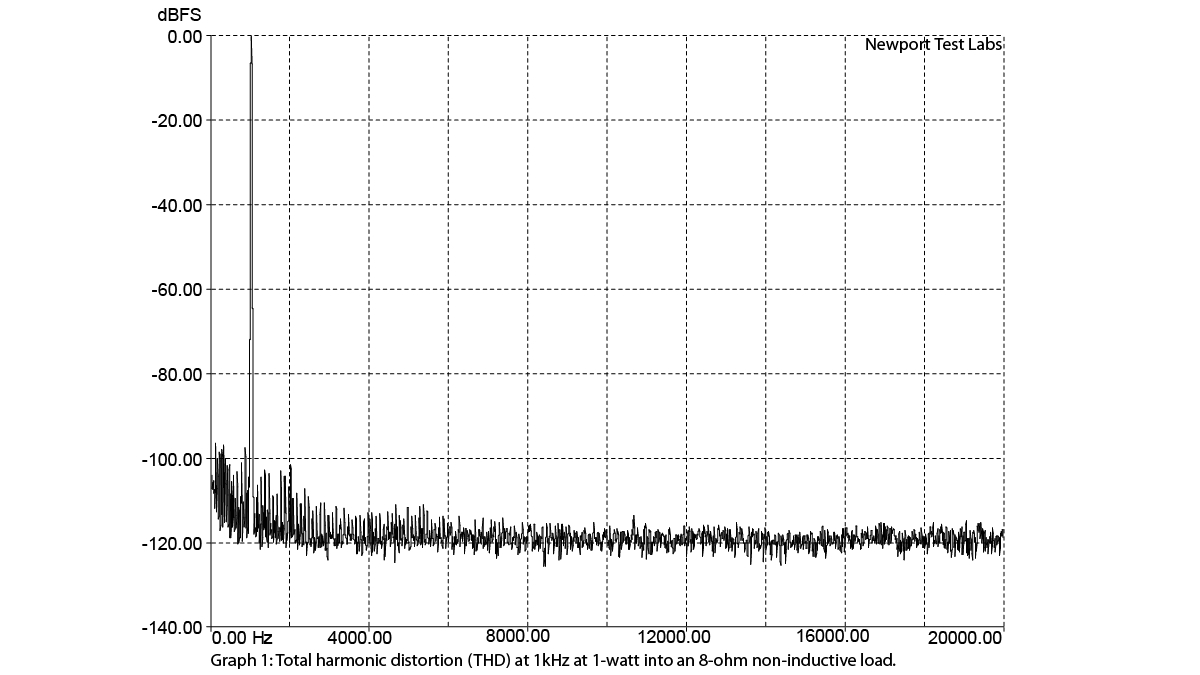
Measured distortion at an output of 1-watt was low into both 8Ω and 4Ω loads, as you can see for yourself in graphs 1 (above) and 2 (below). Driven into 8Ω there is a second harmonic distortion component at –102dB (0.00079%). There could be a third harmonic component at around –115dB (0.00017%) but if so, it’s buried in the noise floor.
Above this I could see no more distortion components, and would have you note that the overall noise floor is down at –120dB, which is particularly good since it’s referred to an output of just one watt.
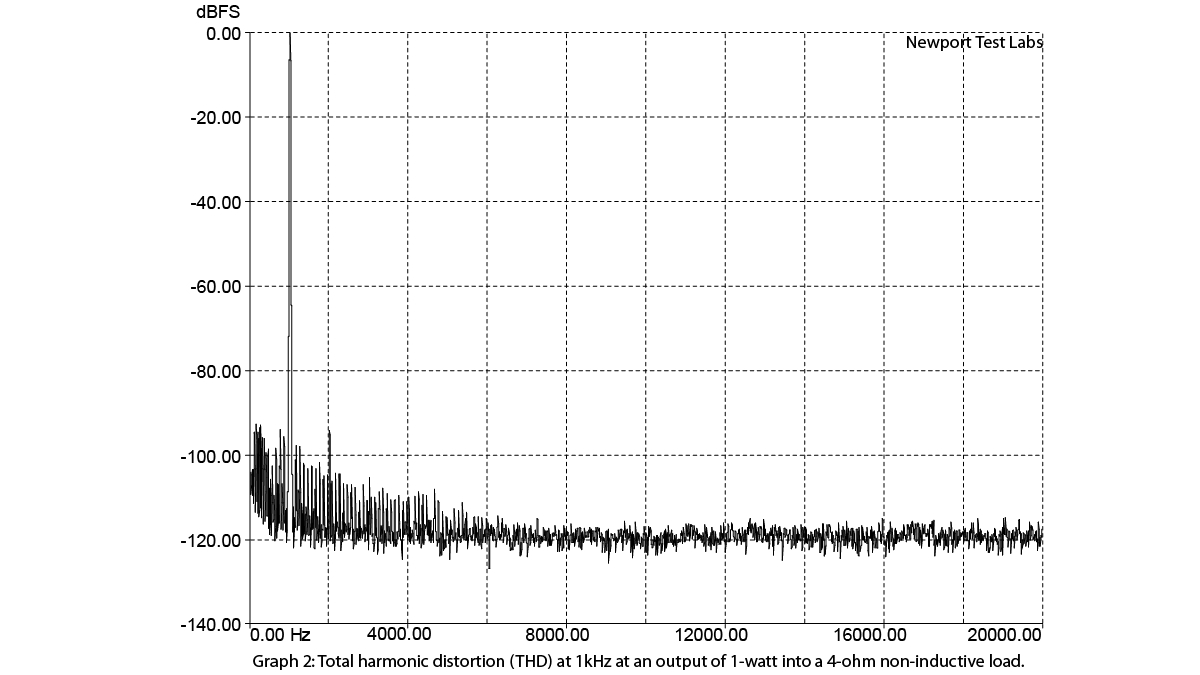
Into 4Ω (Graph 2) the level of the second harmonic distortion component increases to –95dB (0.00177%) and the third to –110dB (0.00031%) but no higher-order components become visible above the noise floor.
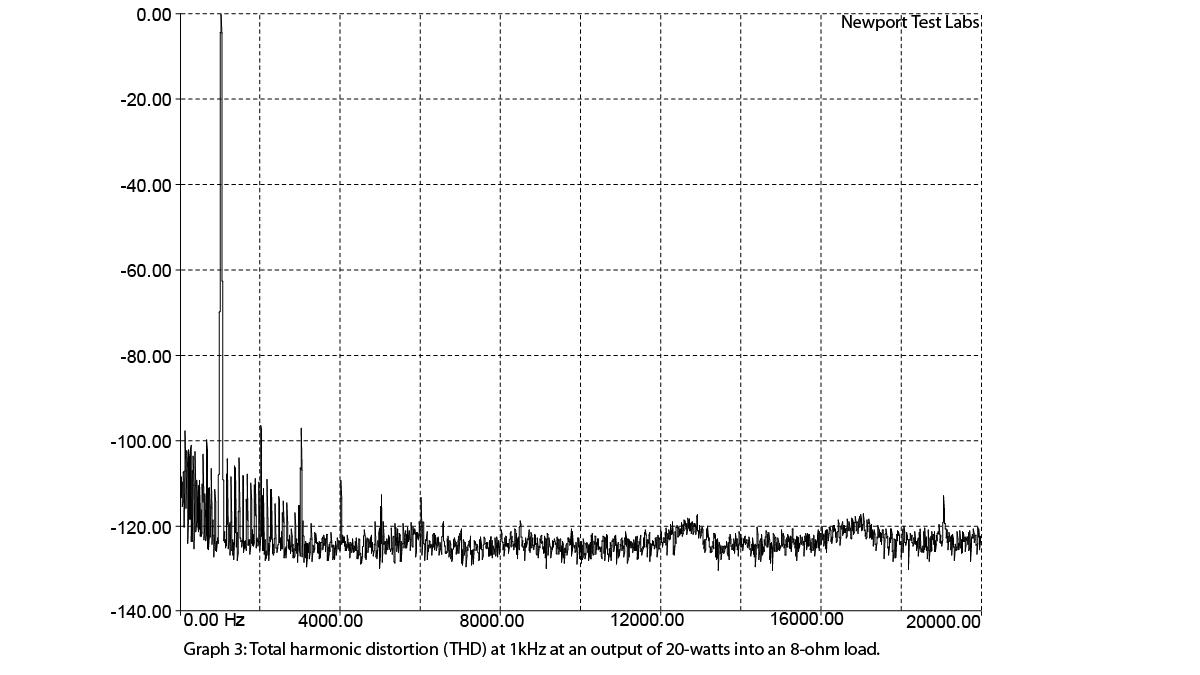
Increasing the power output to 20-watts, which is a more real-world output level in home hi-fi terms, you can see second- and third-order components on the Graph 3, showing the 8 ohm load result, at around –97dB (0.00141%), a fourth at –109dB (0.00035%) and a fifth and sixth at around –114dB (0.00019%). As expected, the noise floor has dropped a little, due to the higher (20-watt) reference level.
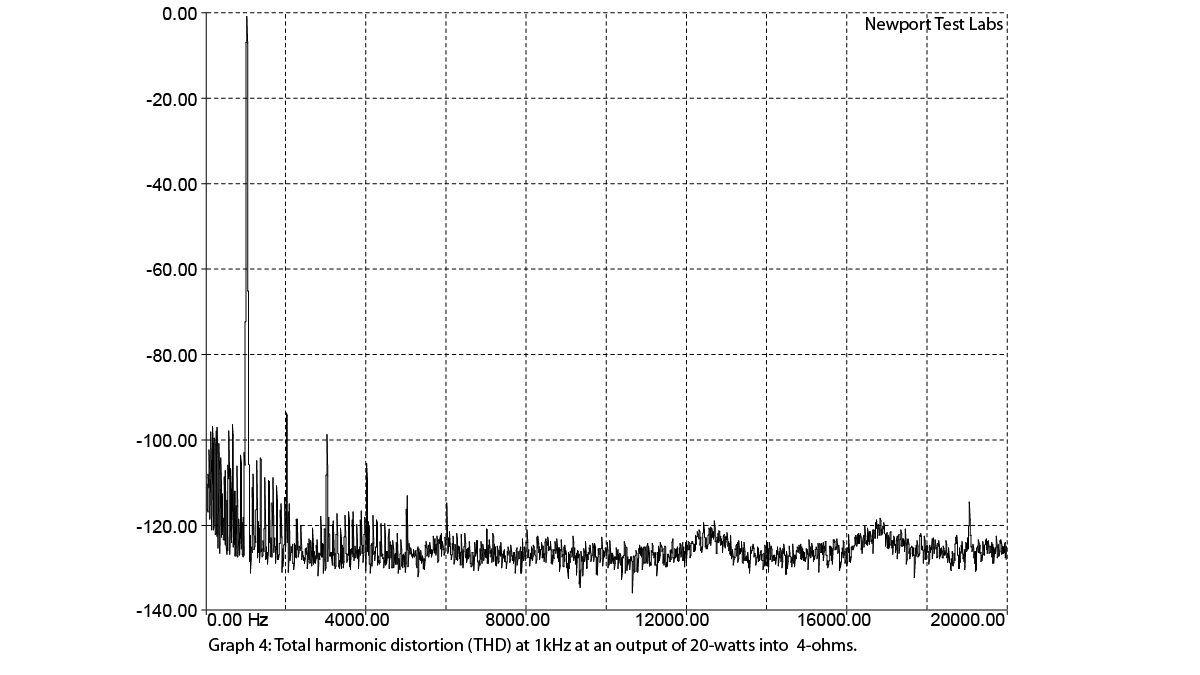
Again, distortion levels increased when load impedance was halved, as shown in Graph 4but the distortion ‘signature’ was very similar to that with the 8Ω load. It is important to note that low-order harmonic distortion components, particularly the 2nd and 3rd, are perceived by the human ear as making the fundamental sound richer and warmer, by virtue of being musically related (octave and fifth), so their presence is not really of any concern, even if they’d been present in much higher levels than they were on the M8xi.
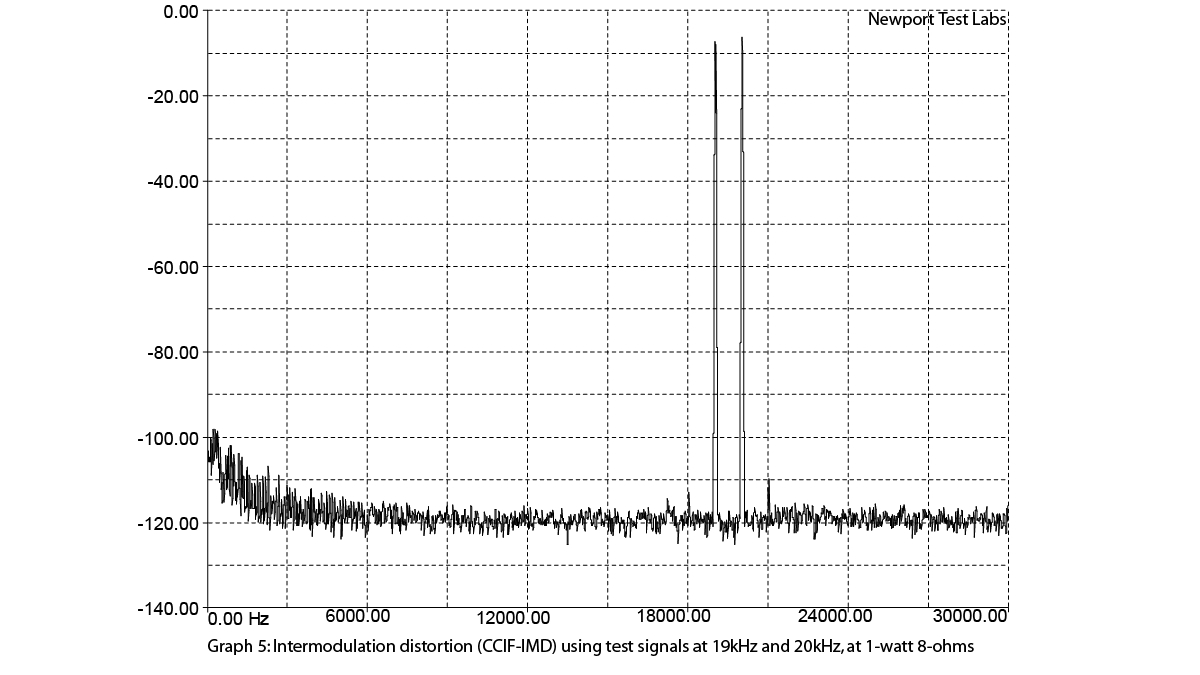
Newport Test Labs, as usual, also measured intermodulation distortion at two power levels, using a CCIF-IMD test signal which has 19kHz and 20kHz test signals at equal levels. The Musical Fidelity M8xi’s result at 1-watt is shown in Graph 5 and you can see it’s a stunningly good result, with only two high-frequency sidebands, one at –115dB (0.00017%) and the other at –111dB (0.00028%) while the regenerated difference signal at 1kHz is, if it’s present, lost in the noise floor at –118dB.
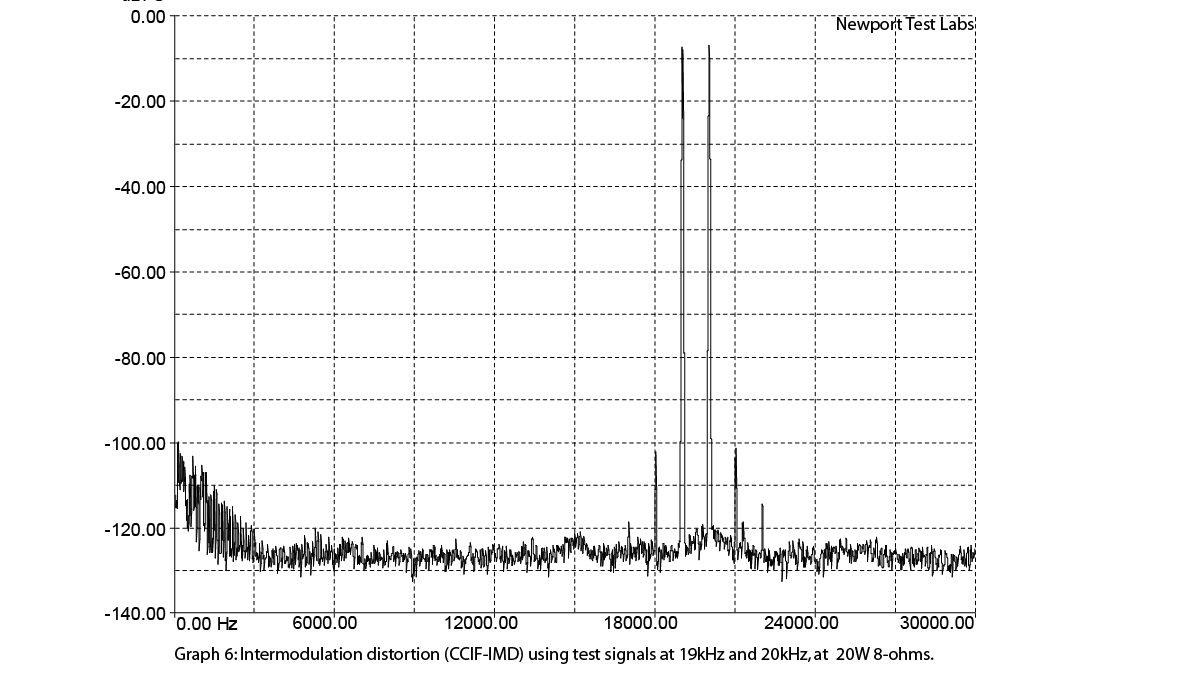
At the higher output level of 20-watts into an 8 ohm load, as shown in Graph 6 (above) there is still no unwanted regenerated signal present, even though the noise floor has dropped down below –122dB. The level of the two high-frequency sidebands has increased, but both are still more than 100dB down (0.001%). These IMD results are so stunningly good that I wondered if the performance on this particular test signal was in some way related to the bridged nature of the amplifier’s output stage. Some homework for me.
Newport Test Labs measured the –3dB points of the Musical Fidelity M8xi’s frequency response at 6Hz and 160kHz, which proves that it’s a very wideband design. The frequency response is also very flat over an extraordinarily wide bandwidth, as is evidenced by the 1dB downpoints listed in the tabulated results. Overall, the normalised frequency response of the Musical Fidelity M8xi was measured as 12Hz–70kHz ±0.5dB.
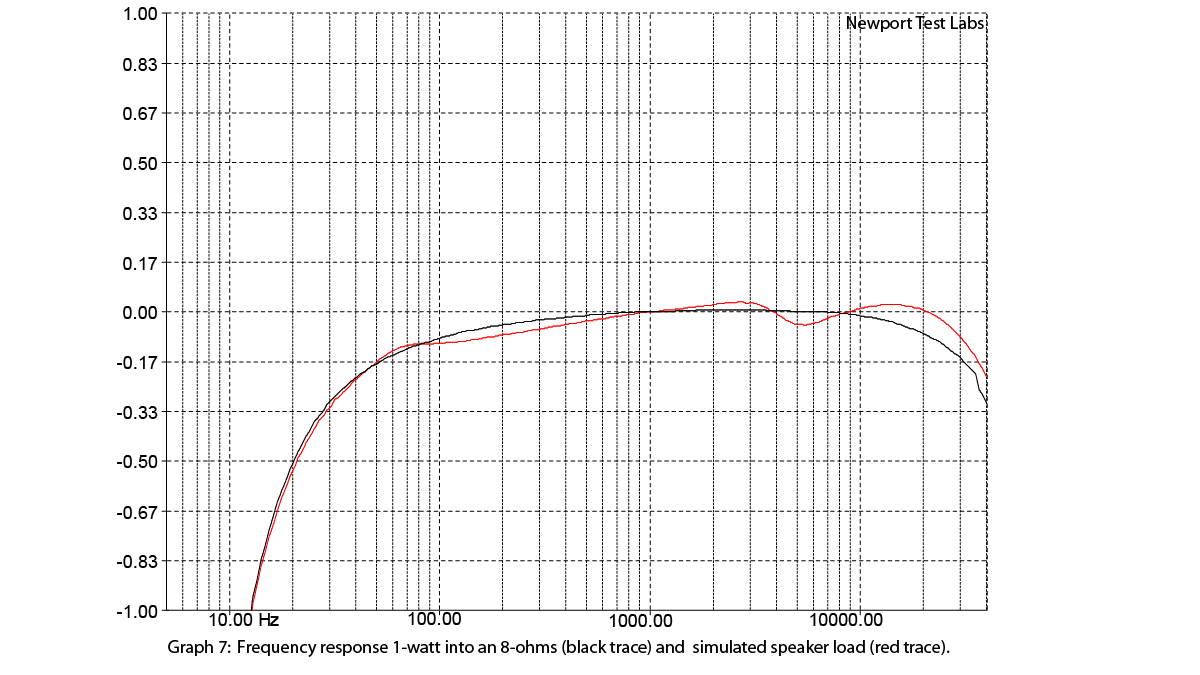
The Musical Fidelity M8xi’s frequency response across the audio band is shown in Graph 7, in which graph the black trace represents the response when the amplifier is driving a standard non-inductive 8Ω laboratory test load and the red trace shows its response when driving a test load that simulates the impedance of a typical two-way bass reflex loudspeaker system.
Channel separation was excellent, as you can see from the tabulated results (below), with the Musical Fidelity M8xi returning a best result of 103dB at 20kHz and a very nearly three-figure result at 1kHz. Separation diminished a little at 20kHz, as it usually does with all audio amplifiers, but it was still an excellent 76dB, which is more than enough to guarantee perfect stereo imaging and ear-perfect separation between channels.
Balance between channels was also outstandingly good, with Newport Test Labs measuring a difference in level between the left and right channels of just 0.03dB. This difference in levels would be completely inaudible.
Newport Test Labs measured the M8xi’s signal-to-noise ratio at 86dB A-weighted referenced to an output of 1-watt and 94dB A-weighted referenced to rated output. The 94dB figure is a particularly good result for an integrated amplifier, but of course it is ‘improved’ due to the high output power of the M8xi.
Output impedance was very good for this type of amplifier design, with Newport Test Labs measuring it as 0.05Ω to give a damping factor (at 1kHz) of 160.
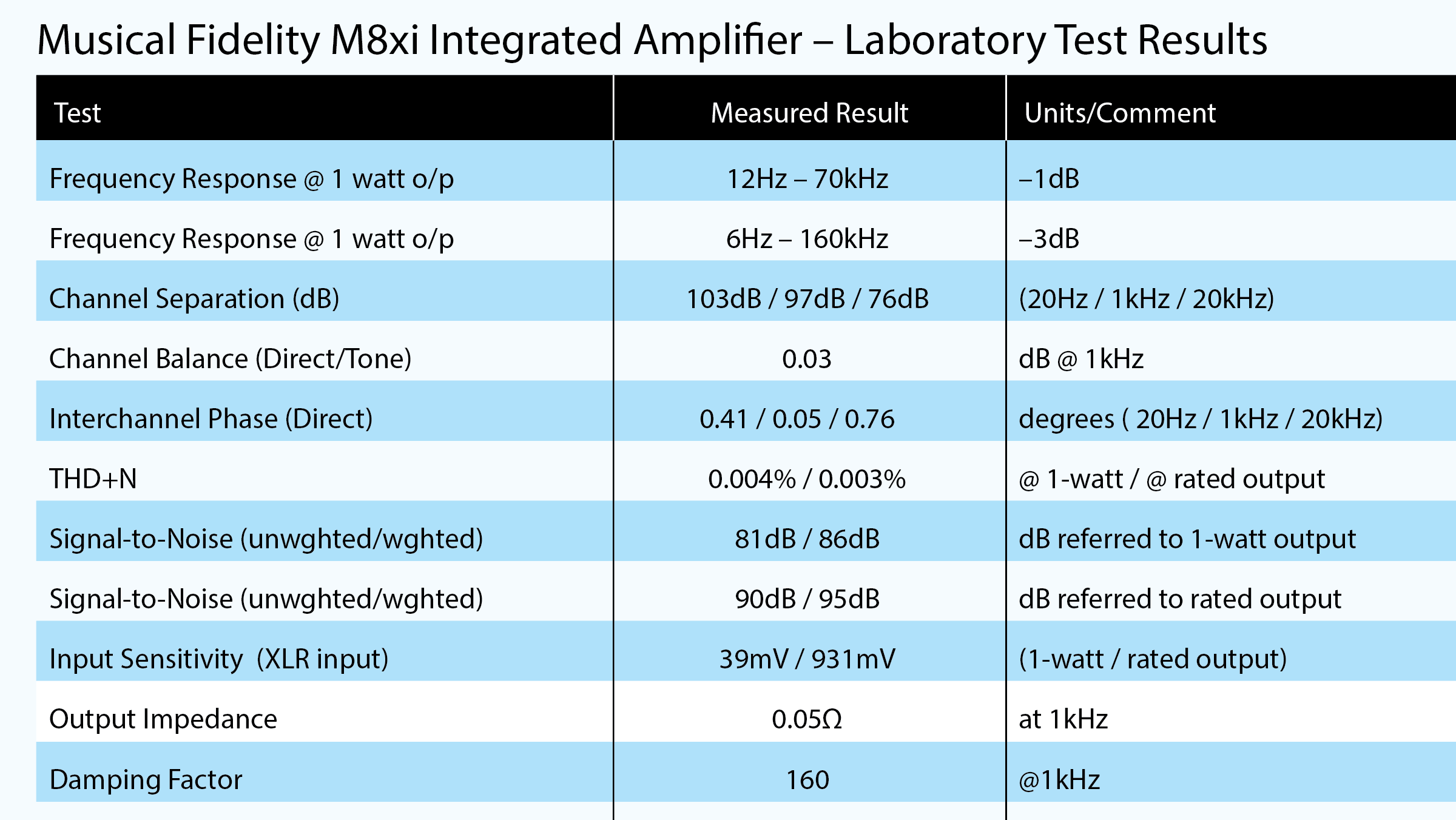
As you can see from the tabulated results, stand-by power consumption was better than the Australian standard, with the M8xi drawing only 0.22-watts in standby. Whilst operating at typical playback levels I’d expect an average power draw of around 200-watts. Flat out, it will drag 2,371-watts from your power supply, so best not to have too many other appliances on the same household circuit if you regularly play loud music!
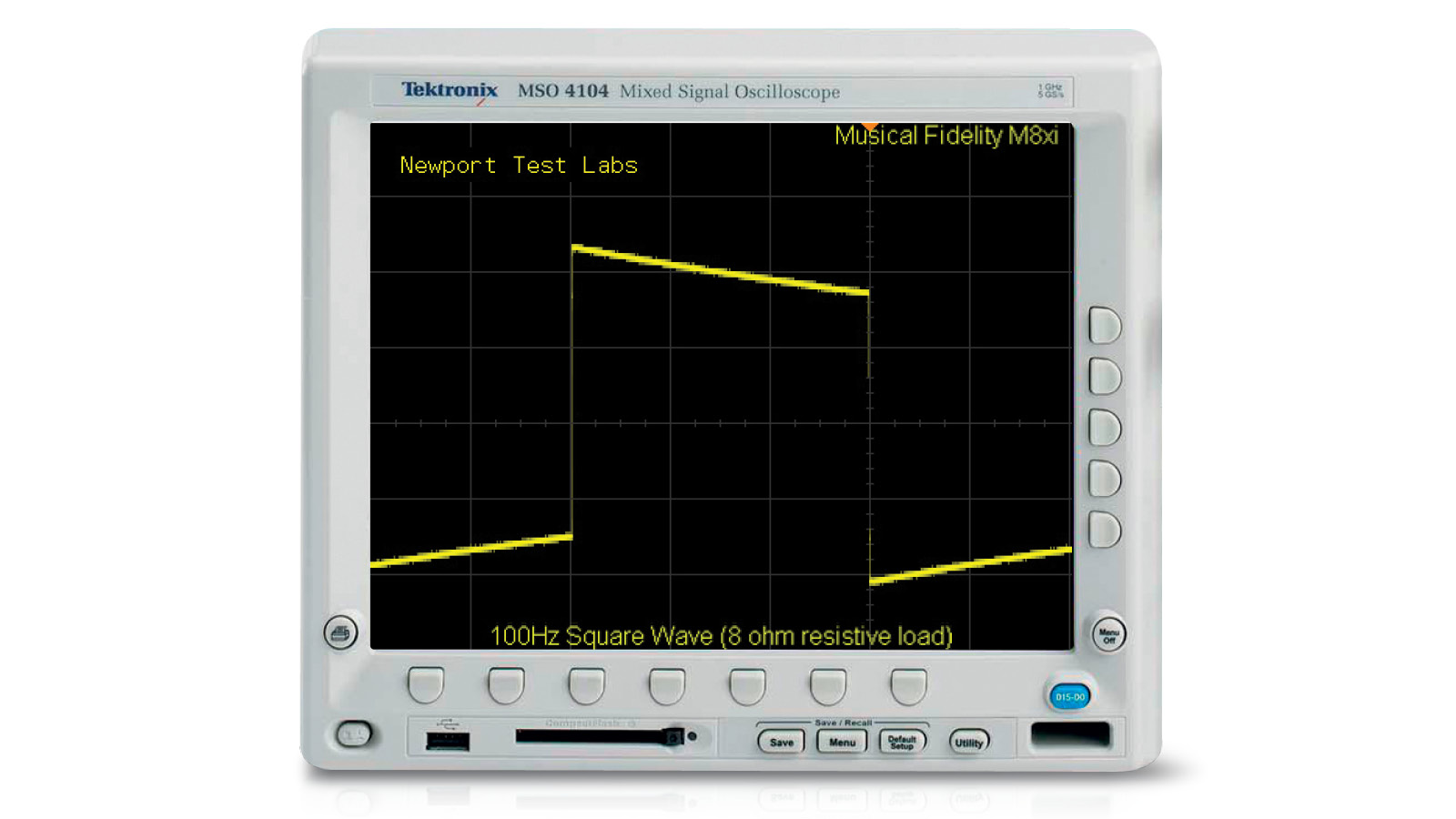
The 100Hz square wave oscillogram captured by Newport Test Labs shows that the low-frequency response of the Musical Fidelity M8xi does not extend to d.c., plus that there’s a small amount of phase shift at low frequencies.
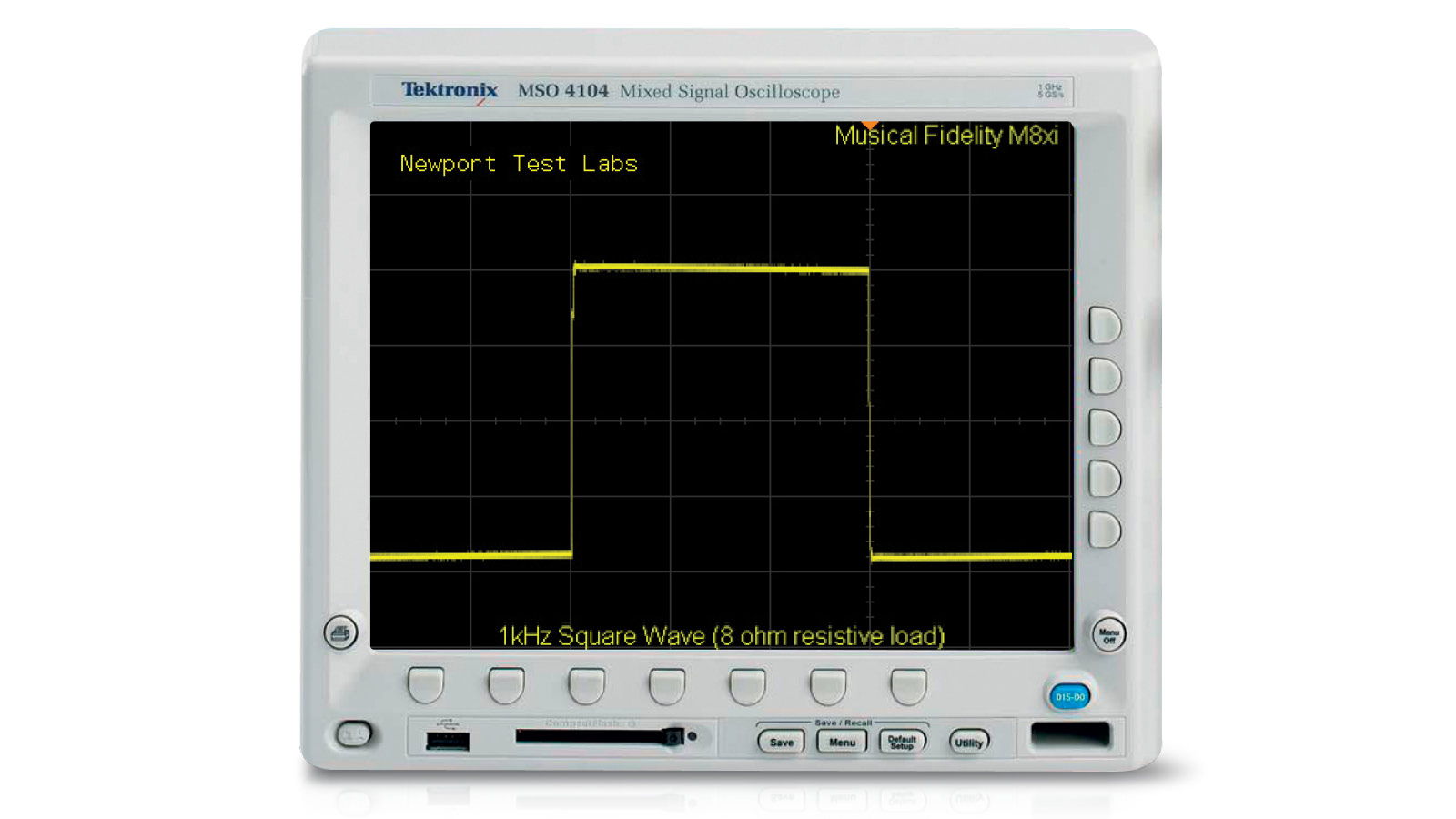
The 1kHz square wave is very good. There’s a slight irregularity on the leading edge, but this could have been due to the presence of the differential probe necessary when testing an amplifier with a bridged output stage.
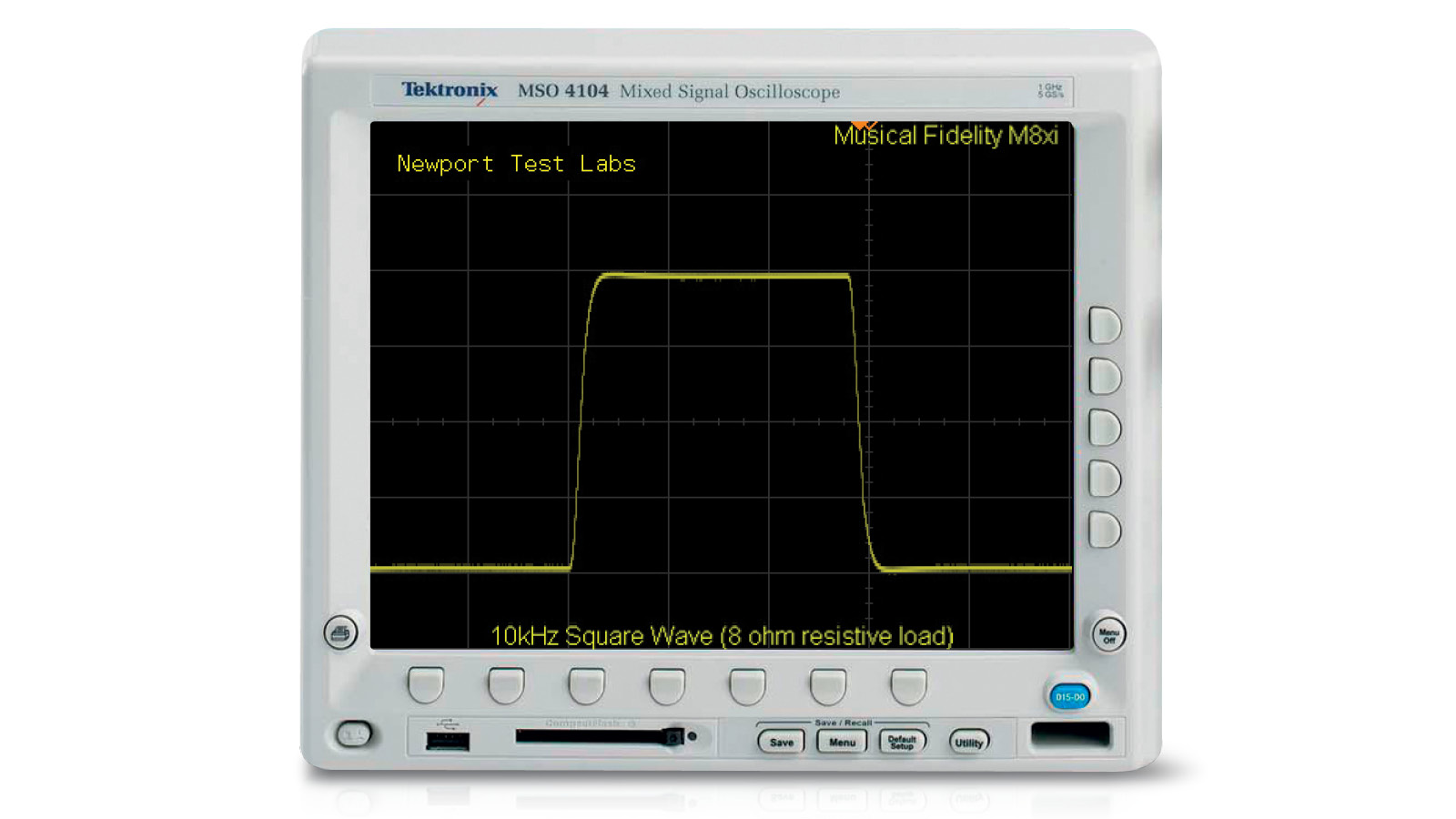
The rise time on the 10kHz waveform is very fast, reflecting the M8xi’s extended high-frequency response.
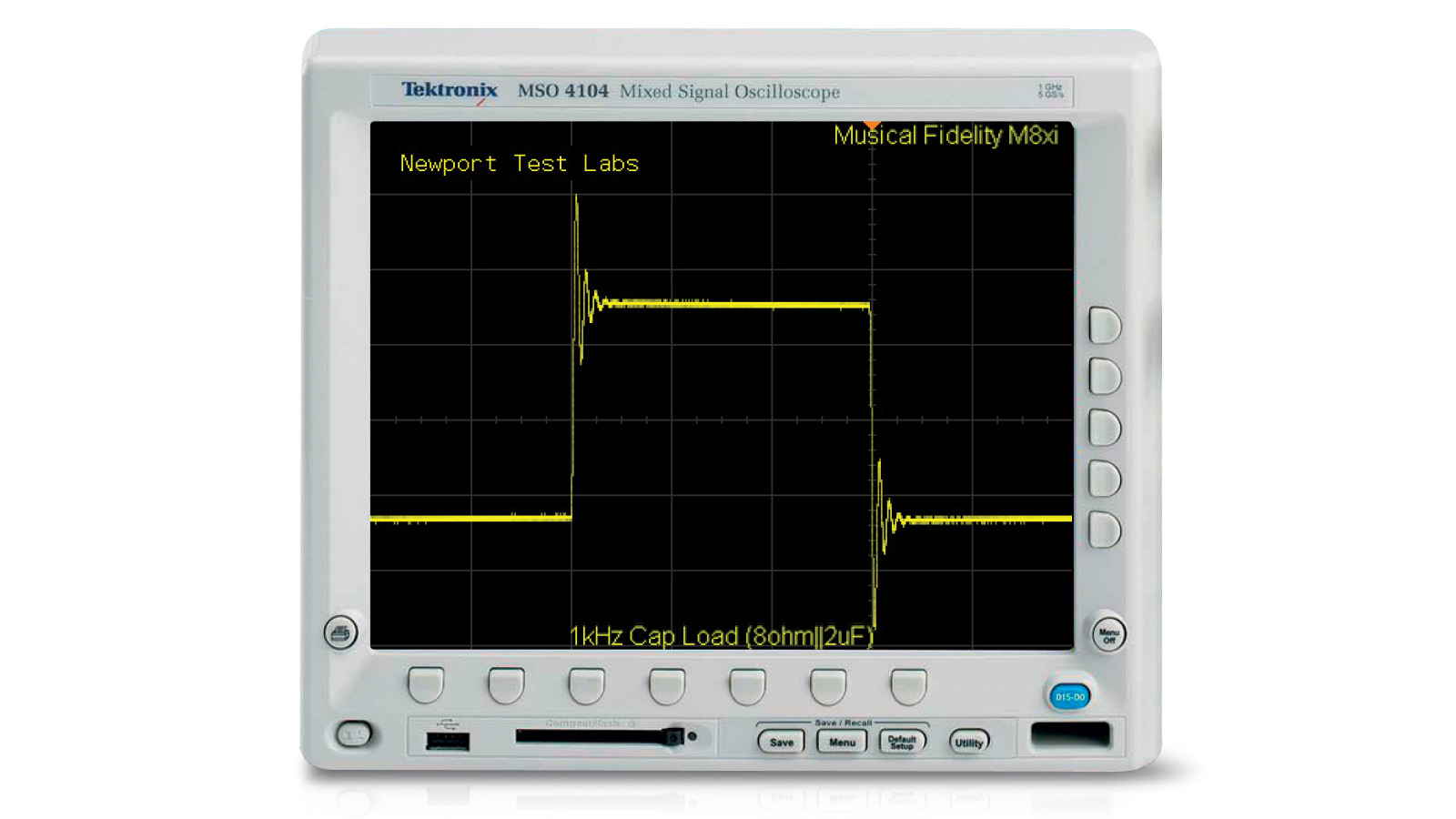
The oscillogram showing the waveform of a square wave when the Musical Fidelity is driving a highly reactive load (2µF in parallel with 8Ω) shows that Musical Fidelity is more than justified in claiming that the M8xi is ‘unconditionally stable.’ but there’s a bit more ringing than I usually see.
Because of the design of its output stage, the Musical Fidelity M8xi’s positive and negative speaker terminals are what is called ‘hot’ in that they both carry voltage. This means that you should be very careful connecting anything other than conventional passive loudspeakers to the output.
If you do want to connect anything at all other than ordinary passive loudspeakers (an active subwoofer, electrostatic loudspeakers, etc) I would suggest contacting Musical Fidelity’s distributor before doing so, otherwise the amplifier could be damaged, and such damage would not be covered by warranty.
I was interested to see that Musical Fidelity’s promotional brochure says the M8xi “will drive any loudspeaker in existence easily with ample power reserve” because manufacturers of amplifiers with bridged outputs usually recommend using loudspeakers with a nominal impedance of 4Ω or more. I certainly would.
The Musical Fidelity M8xi’s performance on Newport Test Labs’ test bench was outstandingly good. It is a very well-designed, high-power, low-distortion, high-performance amplifier.
Australian Hi-Fi is one of What Hi-Fi?’s sister titles from Down Under and Australia’s longest-running and most successful hi-fi magazines, having been in continuous publication since 1969. Now edited by What Hi-Fi?'s Becky Roberts, every issue is packed with authoritative reviews of hi-fi equipment ranging from portables to state-of-the-art audiophile systems (and everything in between), information on new product launches, and ‘how-to’ articles to help you get the best quality sound for your home.
Click here for more information about Australian Hi-Fi, including links to buy individual digital editions and details on how best to subscribe.
